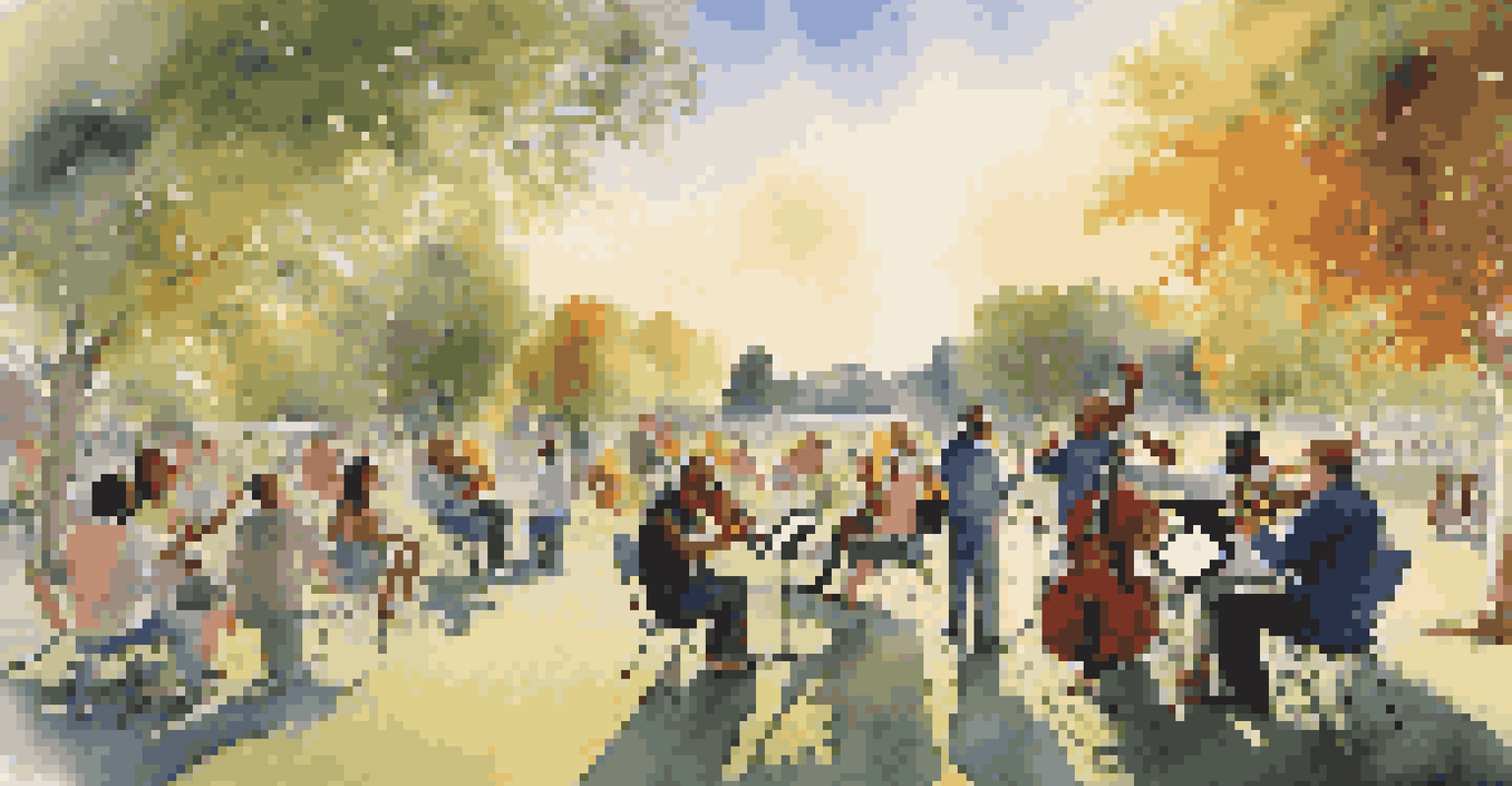Music Composition for Beginners: Essential Skills to Master

Understanding Music Theory: The Foundation of Composition
Music theory is the backbone of composition; it helps you understand how music works. At its core, it involves elements like scales, chords, and rhythm, which are essential for creating melodies and harmonies. By grasping these concepts, you’ll find it easier to express your musical ideas on paper or digitally.
Music is the shorthand of emotion.
For instance, learning about major and minor scales can give you insight into the emotional qualities of music. Major scales often sound happy, while minor scales can convey sadness or tension. This knowledge allows you to choose the right scale for the mood you want to create.
Moreover, understanding chord progressions is crucial. These are the sequences of chords that provide the harmonic backdrop to your melodies. Familiarizing yourself with common progressions, like the I-IV-V, can greatly enhance your compositions and give them a professional touch.
Developing Melodic Skills: Crafting Catchy Tunes
A melody is the memorable part of a song that listeners hum along to. To create effective melodies, try experimenting with different note patterns and rhythms. Start simple; even a few notes can form a catchy tune if they are placed thoughtfully.

An excellent way to hone your melodic skills is through ear training. This practice involves listening to melodies and trying to replicate them on your instrument or through singing. It helps you internalize musical ideas and develop your unique style.
Music Theory is Essential for Composers
Understanding music theory, including scales, chords, and rhythm, is crucial for effectively expressing musical ideas.
Additionally, consider using a motif, which is a short musical idea that can be developed and repeated throughout your piece. This not only makes your music cohesive but also gives listeners something to latch onto, enhancing their overall experience.
Exploring Rhythm: The Pulse of Your Composition
Rhythm is what makes music feel alive; it’s the beat that gets your foot tapping. Understanding different rhythmic patterns can add depth and excitement to your compositions. Start by experimenting with various time signatures, like 4/4 or 3/4, to see how they change the feel of your music.
The only truth is music.
You can also explore syncopation, which involves placing emphasis on unexpected beats. This technique can create a sense of surprise and keep listeners engaged. Think of how jazz musicians often use syncopation to give their music a unique groove.
Another effective way to develop your rhythmic skills is through drumming. Even if you don’t play the drums, tapping out rhythms on a surface can help you internalize different patterns and apply them to your compositions. Remember, rhythm is just as crucial as melody and harmony in making your music compelling.
Harmonization: Adding Depth to Your Melodies
Harmonization involves adding chords to your melodies to create a richer sound. This is where your understanding of music theory really comes into play. Start by harmonizing simple melodies with basic triads, which are three-note chords built from the scale.
As you grow more comfortable, experiment with different harmonization techniques, such as counterpoint, where two melodies interact with each other. This can create a complex and engaging musical texture that captivates your audience.
Melody and Rhythm Enhance Engagement
Crafting catchy melodies and exploring various rhythmic patterns can significantly enhance listener engagement.
You can also explore extended chords, like seventh and ninth chords, to add color and emotional depth. These chords can evoke different feelings and help to enhance the overall atmosphere of your piece.
Song Structure: Crafting a Cohesive Musical Journey
Having a clear song structure is essential for guiding listeners through your music. Common structures include verse-chorus-verse or AABA formats, each offering a different way to present your ideas. Understanding these frameworks can help you organize your thoughts and maintain listener interest.
Think of song structure like a story; it has a beginning, middle, and end. The verses can introduce themes, while the chorus typically delivers the main message or emotional punch. This balance keeps your composition engaging and memorable.
As you experiment with structure, don't be afraid to break the rules. Many great composers have found success by mixing different structures or creating their own unique formats. Just remember, the goal is to create a satisfying journey for your listeners.
Instrumentation: Choosing the Right Voices for Your Music
Instrumentation refers to the selection of instruments used in a composition. Each instrument has its own unique sound and character, which can significantly impact the mood of your piece. Start by experimenting with different combinations to see how they interact and complement each other.
For example, the warmth of a piano can evoke a sense of intimacy, while the brightness of a guitar might bring a more lively energy. Understanding the strengths and weaknesses of each instrument can help you make informed choices when arranging your music.
Structure and Instrumentation Matter
A clear song structure and thoughtful instrumentation choices are vital for creating a cohesive and impactful musical experience.
Additionally, consider how dynamics and articulation affect instrumentation. Playing softly or using staccato notes can create different textures and feelings. This level of detail in your arrangements can elevate your compositions and make them stand out.
Practice and Feedback: The Keys to Continuous Improvement
Like any skill, music composition requires consistent practice. Set aside dedicated time each week to work on your compositions, experiment with new techniques, and refine your ideas. The more you write, the more comfortable you’ll become with the process.
Seeking feedback from peers or mentors can also be invaluable. Sharing your work with others can provide fresh perspectives and constructive criticism, helping you identify areas for improvement. Remember, feedback is a tool for growth, not a judgment of your talent.

Finally, don’t shy away from studying the works of composers you admire. Analyzing their techniques can inspire your own creativity and help you develop your unique voice. Embrace the journey of learning, and enjoy the process of becoming a better composer.